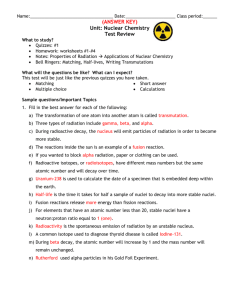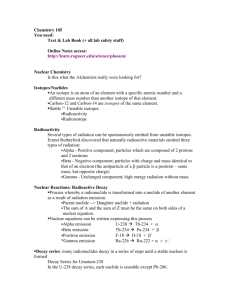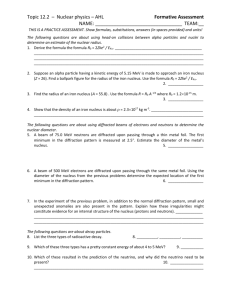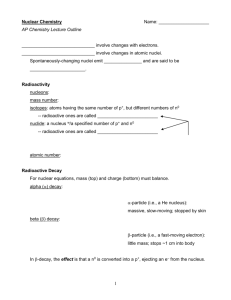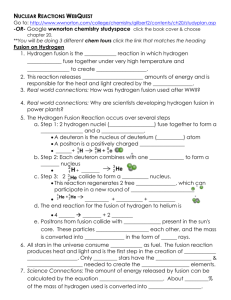Chemical changes: breaking bonds between atoms + rearranging
advertisement
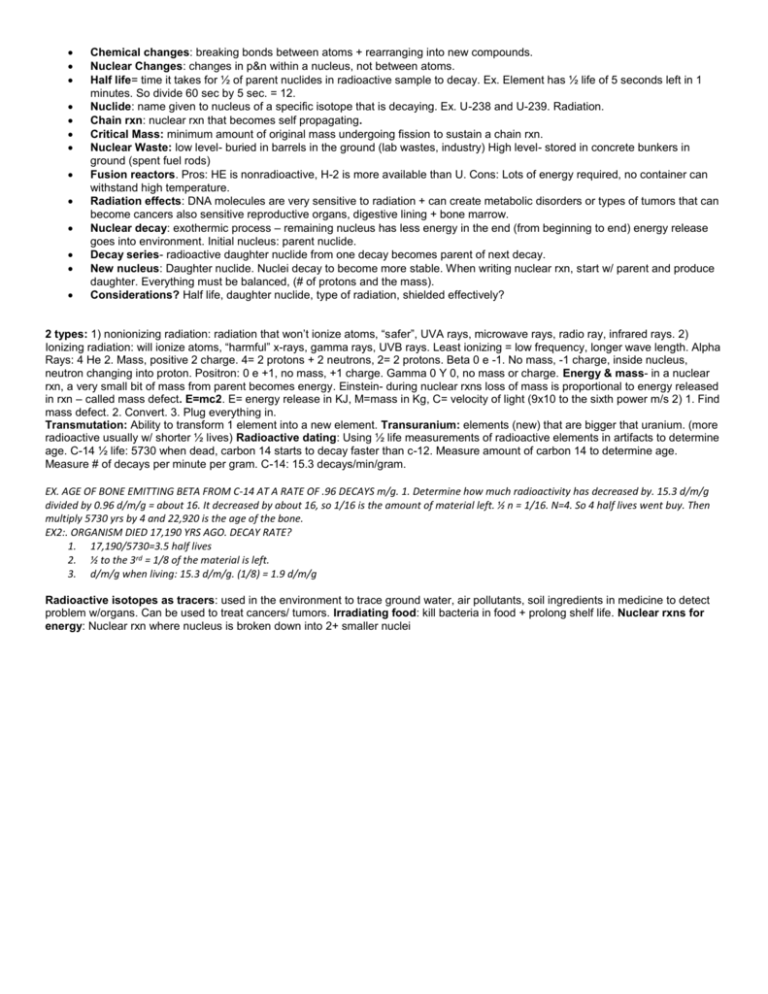
Chemical changes: breaking bonds between atoms + rearranging into new compounds. Nuclear Changes: changes in p&n within a nucleus, not between atoms. Half life= time it takes for ½ of parent nuclides in radioactive sample to decay. Ex. Element has ½ life of 5 seconds left in 1 minutes. So divide 60 sec by 5 sec. = 12. Nuclide: name given to nucleus of a specific isotope that is decaying. Ex. U-238 and U-239. Radiation. Chain rxn: nuclear rxn that becomes self propagating. Critical Mass: minimum amount of original mass undergoing fission to sustain a chain rxn. Nuclear Waste: low level- buried in barrels in the ground (lab wastes, industry) High level- stored in concrete bunkers in ground (spent fuel rods) Fusion reactors. Pros: HE is nonradioactive, H-2 is more available than U. Cons: Lots of energy required, no container can withstand high temperature. Radiation effects: DNA molecules are very sensitive to radiation + can create metabolic disorders or types of tumors that can become cancers also sensitive reproductive organs, digestive lining + bone marrow. Nuclear decay: exothermic process – remaining nucleus has less energy in the end (from beginning to end) energy release goes into environment. Initial nucleus: parent nuclide. Decay series- radioactive daughter nuclide from one decay becomes parent of next decay. New nucleus: Daughter nuclide. Nuclei decay to become more stable. When writing nuclear rxn, start w/ parent and produce daughter. Everything must be balanced, (# of protons and the mass). Considerations? Half life, daughter nuclide, type of radiation, shielded effectively? 2 types: 1) nonionizing radiation: radiation that won’t ionize atoms, “safer”, UVA rays, microwave rays, radio ray, infrared rays. 2) Ionizing radiation: will ionize atoms, “harmful” x-rays, gamma rays, UVB rays. Least ionizing = low frequency, longer wave length. Alpha Rays: 4 He 2. Mass, positive 2 charge. 4= 2 protons + 2 neutrons, 2= 2 protons. Beta 0 e -1. No mass, -1 charge, inside nucleus, neutron changing into proton. Positron: 0 e +1, no mass, +1 charge. Gamma 0 Y 0, no mass or charge. Energy & mass- in a nuclear rxn, a very small bit of mass from parent becomes energy. Einstein- during nuclear rxns loss of mass is proportional to energy released in rxn – called mass defect. E=mc2. E= energy release in KJ, M=mass in Kg, C= velocity of light (9x10 to the sixth power m/s 2) 1. Find mass defect. 2. Convert. 3. Plug everything in. Transmutation: Ability to transform 1 element into a new element. Transuranium: elements (new) that are bigger that uranium. (more radioactive usually w/ shorter ½ lives) Radioactive dating: Using ½ life measurements of radioactive elements in artifacts to determine age. C-14 ½ life: 5730 when dead, carbon 14 starts to decay faster than c-12. Measure amount of carbon 14 to determine age. Measure # of decays per minute per gram. C-14: 15.3 decays/min/gram. EX. AGE OF BONE EMITTING BETA FROM C-14 AT A RATE OF .96 DECAYS m/g. 1. Determine how much radioactivity has decreased by. 15.3 d/m/g divided by 0.96 d/m/g = about 16. It decreased by about 16, so 1/16 is the amount of material left. ½ n = 1/16. N=4. So 4 half lives went buy. Then multiply 5730 yrs by 4 and 22,920 is the age of the bone. EX2:. ORGANISM DIED 17,190 YRS AGO. DECAY RATE? 1. 17,190/5730=3.5 half lives 2. ½ to the 3rd = 1/8 of the material is left. 3. d/m/g when living: 15.3 d/m/g. (1/8) = 1.9 d/m/g Radioactive isotopes as tracers: used in the environment to trace ground water, air pollutants, soil ingredients in medicine to detect problem w/organs. Can be used to treat cancers/ tumors. Irradiating food: kill bacteria in food + prolong shelf life. Nuclear rxns for energy: Nuclear rxn where nucleus is broken down into 2+ smaller nuclei


